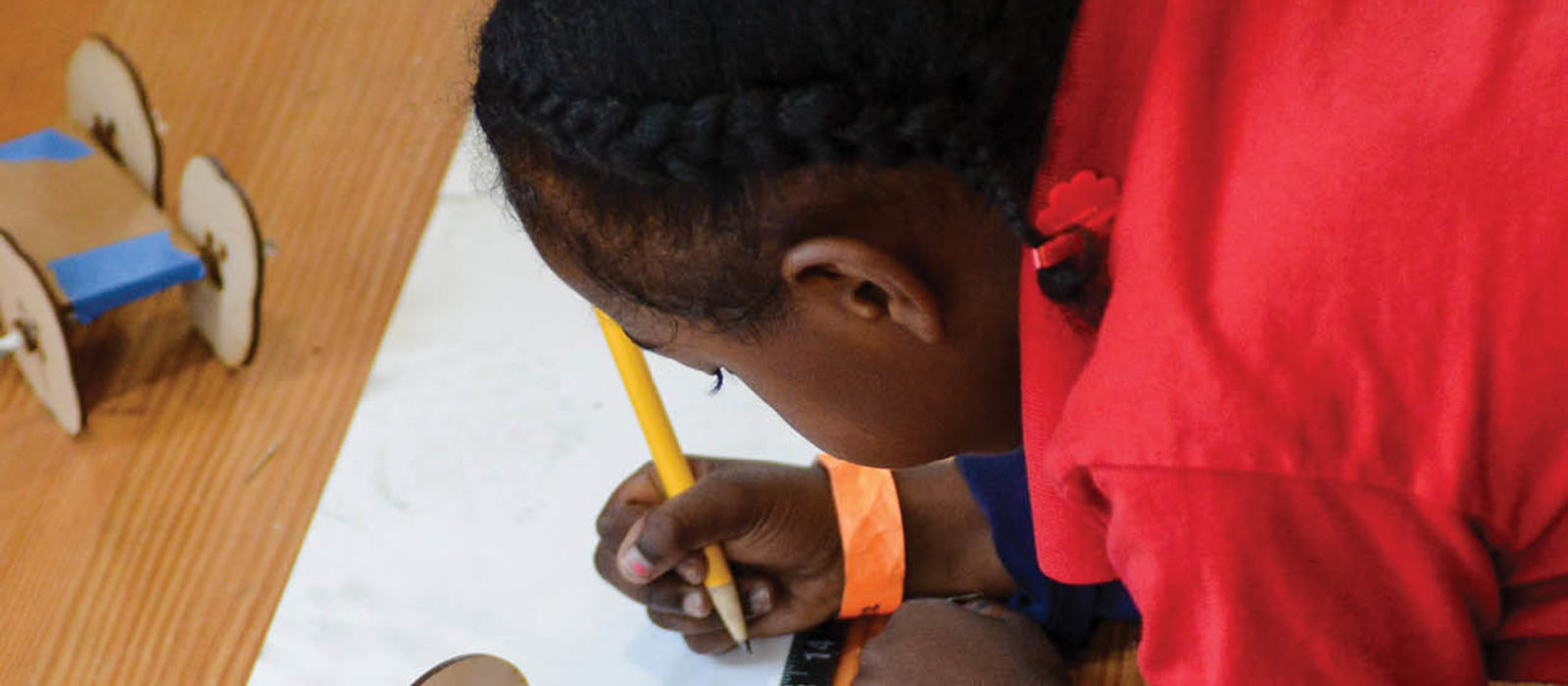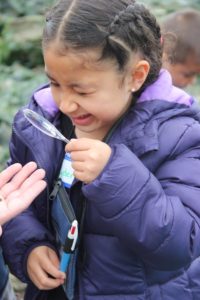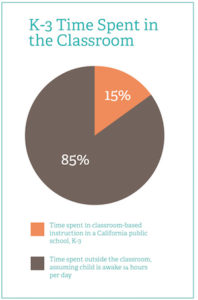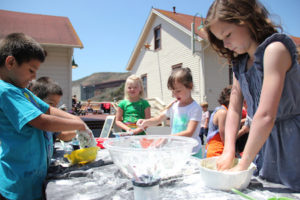The Roots of STEM Success

Changing Early Learning Experiences to Build Lifelong Thinking Skills
In recent years, STEM education—the teaching and learning of science, technology, engineering, and mathematics—has become a national priority. This focus has, in part, been driven by concerns over international competitiveness, dating back to Sputnik and the space race. The focus is also fueled by data showing that young people are not graduating with the skills needed to succeed in a rapidly-evolving, technologically-driven workforce.
A third reason for the focus—one that is particularly important when considering the education of younger children—is the role of STEM in shaping our modern life.
From how food is grown and healthcare delivered, to the ways we get from place to place, save and spend money, consume and evaluate information, and connect to those we love, STEM is transforming our everyday lives. Innovations such as robotics, artificial intelligence, and big data are so dramatically evolving the economy, some leaders believe we are in the midst of the Fourth Industrial Revolution (Schwab, 2016). Additionally, the “grand challenges” of our time—such as providing clean water, controlling carbon emissions, designing new medicines, and securing cyberspace—all require STEM-based solutions (National Academy of Engineering, 2016). STEM understanding can no longer be held by a select few; all children need the underlying thinking dispositions and knowledge to succeed in a STEM-driven economy and world.
There is a growing recognition that STEM educational experiences—particularly, when designed to foster creativity, collaboration, and persistence—lead to greater problem-solving skills and better equip young people for the dynamic world they will face after graduation. This recognition is precipitating big shifts in education. Across the nation, a majority of states are rolling out new science standards that dramatically change how teachers approach science education. Children will be expected to “do” science with much more hands-on, experiential, and collaborative learning, and K-12 standards will include engineering as part of the science curriculum, with a strong focus on creating solutions to problems. Additionally, some school districts are pioneering computer science standards, and STEM-aligned makerspaces—where children can tinker and take things apart, design and create, and play with code and electronics—are increasingly common in both schools and community-based organizations.
Most of the current work in STEM education has focused on older children, however, generally beginning in late elementary or middle school. Developmentally-appropriate, rigorous STEM learning remains a missing link in most children’s early educational experiences, even though research shows that brain development is most robust in a child’s first years of life.
Why an Early Focus Matters
Research tells us that children’s early experience builds brain architecture and lays the foundation for one’s lifelong thinking skills and approach to learning, both critical roots of STEM success. After all, the STEM disciplines require not only content knowledge but also robust thinking dispositions—such as curiosity and inquiry, questioning and skepticism, assessment and analysis—as well as a strong learning mindset and confidence when encountering new information or challenges. These need to be developed in a child’s early education, beginning in infancy and continuing through third grade to lay the roots for STEM success (McClure et al., 2017).
Formal STEM Education
 In the school context, literacy development remains the primary focus through third grade. While learning to read is, of course, a key foundation for academic success, educational experiences that teach children to question, to think, and to effectively communicate ideas matter even more to one’s lifelong success. These are the skills that hands-on, active STEM education can cultivate. Fortunately, research indicates that we need not see this as a zero sum game of either teaching literacy or STEM; in fact, STEM education boosts literacy development by providing opportunity for children to expand vocabulary and practice using language to describe and explain ideas and phenomena.
In the school context, literacy development remains the primary focus through third grade. While learning to read is, of course, a key foundation for academic success, educational experiences that teach children to question, to think, and to effectively communicate ideas matter even more to one’s lifelong success. These are the skills that hands-on, active STEM education can cultivate. Fortunately, research indicates that we need not see this as a zero sum game of either teaching literacy or STEM; in fact, STEM education boosts literacy development by providing opportunity for children to expand vocabulary and practice using language to describe and explain ideas and phenomena.
Mathematics is also emphasized in our schools. And while new mathematics standards expect more creative problem solving and more exploratory thinking, in many classrooms, mathematics remains a performance, rather than a rigorous process of thinking, creating, or analyzing. Additionally, few classroom teachers are equipped with the skills or knowledge to help children apply math learning to the world around them or connect it meaningfully to other STEM disciplines. The teaching of mathematics rarely helps children appreciate it as a universal tool of scientific discovery and engineered innovation.
Science—let alone engineering or computer science—is rarely introduced in a meaningful, consistent way until late in the elementary years. In fact, whether a child receives any science education in the elementary years depends, at present in most districts, on luck of assignment to a class whose teacher chooses to include science lessons and experiences. New science-based assessments, aligned to the Next Generation Science Standards, are beginning to be implemented in elementary schools. However, science-based standardized testing for elementary students occurs only in the fourth grade1, while assessments in literacy and mathematics begin in third grade and continue each year through a child’s academic life. Because teachers are measured by these assessments, they feel pressure to focus their precious instructional time on literacy and mathematics. Moreover, most teachers struggle to know how to build either language or mathematical skills through interdisciplinary approaches.
Additionally, adults struggle to reimagine science and mathematics as a flexible or collaborative problem-solving process. While new school-based standards demand a shift in approach, with less rote memorization and more opportunity for creative, team-based, and iterative problem solving (such as we see in the modern workplace), teachers and parents alike tend to hold on to preconceived ideas of what makes for good learning, often reverting back to their own experiences of math and science instruction and asking children to recall information, rather than do challenging thinking and questioning. This is compounded by the fact that outdated understandings of learning and intelligence persist, particularly in regards to STEM capability. Teachers and parents regularly and unwittingly communicate to children that some people “just aren’t” math or science people. While most teachers and parents would find it unthinkable to say to their children, “I’m a terrible reader,” it is all too common to hear adults declare that they, “have never been good at math.” Research demonstrates that these messages shape children’s mindsets significantly and have particularly negative effects on groups underrepresented in STEM fields, including girls and children of color (Aronson, 2007; Dar-Nimrod & Heine, 2006).
1 Testing content and grade-levels vary across states; these represent the expectations of California public schools.
Informal STEM Education
 Increasingly, communities are seeking to bridge children’s learning inside and outside the school walls and are considering how informal learning spaces (including museums, libraries, educational technology, and community-based organizations offering afterschool and summer programs) along with strengthened family learning can complement and deepen children’s school-based STEM education. This is particularly important in the early years of formal schooling, from kindergarten through third grade, when children spend only 15 percent of their waking time in class. Given that many children do not have access to formal school until age five, and that nearly all children spend the first three years of their lives in informal environments (e.g., in childcare or with family), this overall percentage is even lower when considering the amount of time children spend learning in school-based classrooms over their first eight years.
Increasingly, communities are seeking to bridge children’s learning inside and outside the school walls and are considering how informal learning spaces (including museums, libraries, educational technology, and community-based organizations offering afterschool and summer programs) along with strengthened family learning can complement and deepen children’s school-based STEM education. This is particularly important in the early years of formal schooling, from kindergarten through third grade, when children spend only 15 percent of their waking time in class. Given that many children do not have access to formal school until age five, and that nearly all children spend the first three years of their lives in informal environments (e.g., in childcare or with family), this overall percentage is even lower when considering the amount of time children spend learning in school-based classrooms over their first eight years.
In many cities and regions, community-based organizations and education institutions (like museums) are partnering with school districts and employers to develop “badging” systems through which youth’s out-of-school time learning can be credited and recognized as preparation for adult life and work. This blurring of boundaries between learning environments represents a significant shift in how we think about educating our children. Their needs are now far broader—and more complex—than the basic school outcomes of reading, writing, and arithmetic.
Community resources and out-of-school time learning are needed to provide the holistic STEM education children need for their futures. Yet, the majority of badging programs and STEM learning spaces target middle and high schoolers, and most funding for STEM education is tied to “workforce development” and the latter years of schooling.
STEM Learning at Home
Currently, parents and caregivers are far more comfortable supporting their children’s literacy development—reading with and to their young children—than they are incorporating STEM learning at home. Families do not yet recognize the potential of home-based activities such as building, fixing, crafting, shopping, cooking, gardening, self-care, watching sports, and cleaning to inspire children’s STEM-based questions and build their STEM content knowledge.
Additionally, while families increasingly look to apps to engage their children, most families struggle to know how to find apps—from the dizzying array of choices—that have meaningful educational value. Few apps with math, science, or engineering content are designed in a way to build children’s creative problem-solving skills. And while children use technological devices as the medium for playing with apps, there is minimal learning about technology embedded in most apps. Additionally, research shows that technology-based learning is most effective for children in preschool and early elementary school when it is coupled with interaction, conversation, and support from adults (Donohue & Schomburg, 2017). Yet families are largely unaware of this research-based best practice, and few apps are designed to be used with adults and children together.
 The lack of developmentally-appropriate, strong STEM learning opportunities for families with young children represents a great opportunity for informal education providers to better serve the needs of the community. To leverage families’ learning time, informal educators—including librarians, museum professionals, afterschool and childcare providers, camp counselors, and toy and media designers—need support in bringing STEM education to children zero through eight. Some informal educators have strong science, engineering, or math content knowledge but little understanding of children’s development or learning needs; others are strong with young children but lack the content expertise or confidence to infuse STEM learning into activities. Some struggle to know how to design STEM experiences that are open-ended enough to allow for creative thinking; others struggle to know how to present abstract ideas and phenomena in ways that are approachable and developmentally appropriate for younger children. At present, there is great need and opportunity to strengthen informal learning experiences to bring age-appropriate, challenging, creative, and content-rich STEM learning to young children.
The lack of developmentally-appropriate, strong STEM learning opportunities for families with young children represents a great opportunity for informal education providers to better serve the needs of the community. To leverage families’ learning time, informal educators—including librarians, museum professionals, afterschool and childcare providers, camp counselors, and toy and media designers—need support in bringing STEM education to children zero through eight. Some informal educators have strong science, engineering, or math content knowledge but little understanding of children’s development or learning needs; others are strong with young children but lack the content expertise or confidence to infuse STEM learning into activities. Some struggle to know how to design STEM experiences that are open-ended enough to allow for creative thinking; others struggle to know how to present abstract ideas and phenomena in ways that are approachable and developmentally appropriate for younger children. At present, there is great need and opportunity to strengthen informal learning experiences to bring age-appropriate, challenging, creative, and content-rich STEM learning to young children.
This paper was authored to support classroom teachers, informal educators, experience designers, and families seeking an evidence-based approach to STEM learning for young children.
Key Findings
Based on the review of more than 150 empirical studies from cognitive and developmental psychology and education, the Center for Childhood Creativity finds that children are capable of remarkable problem solving from the earliest of years. At the same time, adult guidance, support, and awareness are critical to harnessing our intrinsic STEM capacity and transforming it into lifelong STEM intelligence, knowledge, and capability. Specifically, we offer these six research-backed findings:
1. STEM thinking begins in infancy
Counter to long-held assumptions about babies and toddlers’ cognitive capacity, we now know that STEM thinking starts in infancy. Even before a child’s first birthday, she is capable of making inferences, drawing conclusions about cause and effect, and reasoning about the probability of events. These roots, which lay the groundwork for later abstract reasoning, must be encouraged through engagement and play in order for inherent tendencies to develop into lifelong STEM thinking skills.
2. To become strong STEM thinkers, children need more play
Play is not frivolity and fluff; it is the brain’s wired-in process for learning. Through play of all sorts—from building to board games, from make-believe to magic tricks—children are testing theories about how the world works and developing the brain plasticity for lifelong learning. Guided play, where adults follow the child’s lead and shape the learning experience through thoughtful questions and interaction, has been shown to be particularly effective for teaching STEM content. STEM education should include robust, frequent, and varied opportunities for play through the third grade.
3. STEM amplifies language development; language enables STEM thinking
As children engage in STEM experiences, they hear and practice new words. Growing vocabularies allow children to make sense of increasingly complex ideas and phenomena, and early exposure to vocabulary used for concepts can support children later on to master higher order thinking. Questions are particularly important—for adults to ask of children and for children to learn to ask themselves—in order to guide problem-solving and thinking strategies. Spatial reasoning—the capacity to envision and mentally manipulate objects in space, which is particularly key in engineering and mathematics—can be developed through language exchange.
4. Active, self-directed learning builds STEM skills and interest
Hands-on STEM learning is not only more fun, it is also more effective at helping children make sense of information that is complex or abstract. Museums and community-based organizations complement children’s in-school STEM education by providing families with guided, hands-on learning and by giving children the opportunity to self-direct exploration and inquiry, which correlates to long-term interest in STEM. Technology is increasingly seen as another avenue for self-directed learning, though further work and scholarship are needed in this area.
5. Mindset matters to STEM success
Developing what psychologists call a “growth” mindset—believing that learning and improvement will follow hard work and intentional effort—is particularly important in STEM learning, especially as children move from early to middle childhood. Adults need to support children, particularly girls and children of color, to develop a growth mindset with the STEM disciplines.
6. Children’s abstract thinking potential can be unlocked through both adult support and executive function skill development
Modern research debunks the myth that children are concrete thinkers, only capable of making sense of what they can directly see and experience. Instead, we now understand that children can grapple with abstract ideas and phenomena, when challenged and supported to do so. Children with more developed executive function skills (EFs) show greater ease incorporating new information and ignoring irrelevant information during abstract problem solving, so experiences that strengthen EFs are critical to long-term STEM success.

These findings demonstrate the promise and importance of prioritizing STEM learning for children from infancy through third grade, in both schools and through education opportunities outside of school. They also highlight the critical role that adults play during these early years and the need for well-designed STEM experiences that support and challenge children in age-appropriate ways. By focusing on children’s STEM learning during the preschool and earlier elementary years, we can prepare them with the underlying dispositions for STEM thinking, equip them to meet school-based outcomes, and ready them for success in a STEM-rich economy and world.
You can read the full paper here.

